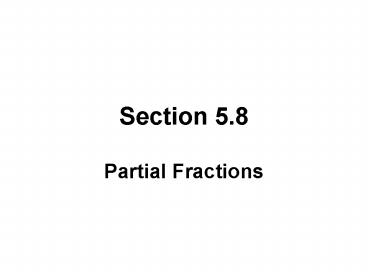Partial Fractions - PowerPoint PPT Presentation
1 / 12
Title:
Partial Fractions
Description:
Example 1. Decompose into partial fractions: ... If we choose x = 3/2, then 2x 3 = 0 and A will be eliminated when we make the substitution. ... – PowerPoint PPT presentation
Number of Views:213
Avg rating:3.0/5.0
Title: Partial Fractions
1
Section 5.8
- Partial Fractions
2
Partial Fractions
3
Example 1
- Decompose into partial fractions
- Solution The degree of the numerator is less
than the degree of the denominator. - Begin by factoring the denominator (x 2)(2x ?
3). We know that there are constants A and B such
that -
. - To determine A and B, we add the expressions
on the right
4
Example 1 continued
- Equate the numerators 4x ? 13 A(2x ? 3) B(x
2) - Since the above equation containing A and B is
true for all x, we can substitute any value of x
and still have a true equation. - If we choose x 3/2, then 2x ? 3 0 and A will
be eliminated when we make the substitution. - This gives us
- 4(3/2) ? 13 A2(3/2) ? 3 B(3/2 2)
- ?7 0 (7/2)B.
- B ?2.
5
Example 1 continued
- If we choose x ?2, then x 2 0 and B will be
eliminated when we make the substitution. So,
4(?2) ? 13 A2(?2) ? 3 B(?2 2) - ?21 ?7A.
- A 3.
- The decomposition is as follows
-
6
Example 2
- Decompose into partial fractions
-
- Solution The degree of the numerator is 2
and the degree of the denominator is 3, so the
degree of the numerator is less than the degree
of the denominator. The denominator is given in
factored form. The decomposition has the
following form
7
Example 2 continued
- Next, we add the expression on the right
-
- Then, we equate the numerators. This gives us
-
- Since the equation containing A, B, and C is
true for all of x, we can substitute any value of
x and still have a true equation. - In order to have 2x 1 0, we let x ½ .
This gives us
Solving, we obtain A 5.
8
Example 2 continued
- In order to have x ? 2 0, we let x 2.
- Substituting gives us
- To find B, we choose any value for x except ½ or
2 - and replace A with 5 and C with ?2 . We let x
1
9
Example 2 continued
- The decomposition is as follows
10
Example 3
- Decompose into partial fractions
11
Example 3 continued
- Solution
- The decomposition has
- the following form.
- Adding and equating numerators, we get
- or
12
Example 3 continued
- We then equate corresponding coefficients
- 11 A 2C, The coefficients of the
x2-terms - ?8 ?3A B, The coefficients of the
x-terms - ?7 ?3B ? C. The constant terms
- We solve this system of three equations and
obtain - A 3, B 1, and C 4.
- The decomposition is as follows































